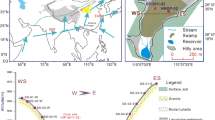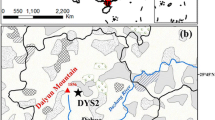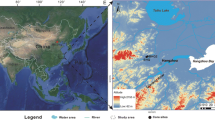Abstract
The Arctic region is very sensitive to climate change and important in the Earth’s climate system. However, proxy datasets for Arctic climate are unevenly distributed and especially scarce for Svalbard because glaciers during the Little Ice Age, the most extensive in the Holocene, destroyed large quantities of sediment records in Svalbard. Fortunately, palaeo-notch sediments could withstand glaciers and be well-preserved after deposition. In this study, we reconstructed a mid-to-late Holocene record of climate changes in a palaeo-notch sediment sequence from London Island. Multiple weathering indices were determined, they all showed consistent weathering conditions in the study area, and they were closely linked to climate changes. Total organic carbon (TOC) and total nitrogen (TN) were also determined, and their variation profiles were similar to those of weathering indices. The climate change record in our sediment sequence is consistent with ice rafting record from North Atlantic and glacier activity from Greenland, Iceland and Svalbard, and four cold periods are clearly present. Our study provides a relatively long-term climate change record for climate conditions from mid-to-late Holocene in Svalbard.








Similar content being viewed by others
References
Alsos I G, Sjögren P, Edwards M E, Landvik J Y, Gielly L, Forwick M, Coissac E, Brown A G, Jakobsen L V and Føreid M K 2016 Sedimentary ancient DNA from Lake Skartjørna, Svalbard: Assessing the resilience of arctic flora to Holocene climate change; The Holocene 26 627–642.
Andersen C, Koc N, Jennings A and Andrews J T 2004 Nonuniform response of the major surface currents in the Nordic Seas to insolation forcing: Implications for the Holocene climate variability; Paleoceanography 19, https://doi.org/10.1029/2002PA000873.
Balascio N L, D’Andrea W J and Bradley R S 2015 Glacier response to North Atlantic climate variability during the Holocene; Clim. Past 11 1587–1598.
Balascio N L, D’Andrea W J, Gjerde M and Bakke J 2016 Hydroclimate variability of high arctic Svalbard during the Holocene inferred from hydrogen isotopes of leaf waxes; Quat. Sci. Rev., https://doi.org/10.1016/j.quascirev.2016.11.036.
Birks H J B, Jones V J and Rose N L 2004 Recent environmental change and atmospheric contamination on Svalbard as recorded in lake sediments – an introduction; J. Paleolimnol. 3(1) 403–410.
Blaauw M 2010 Methods and code for ‘classical’ age- modelling of radiocarbon sequences; Quat. Geochronol. 5 512–518.
Bond G, Kromer B, Beer J, Muscheler R, Evans M N, Showers W, Hoffmann S, Lotti-Bond R, Hajdas I and Bonani G 2001 Persistent solar influence on North Atlantic climate during the Holocene; Science 294 2130–2136.
Bond G, Showers W, Cheseby M, Lotti R, Almasi P, Priore P, Cullen H, Hajdas I and Bonani G 1997 A pervasive millennial-scale cycle in North Atlantic Holocene and glacial climates; Science 278 1257–1266.
Choudhary P, Routh J and Chakrapani G J 2009 An environmental record of changes in sedimentary organic matter from Lake Sattal in Kumaun Himalayas, India; Sci. Total Environ. 407 2783–2795.
Choudhary P, Routh J and Chakrapani G J 2010 Organic geochemical record of increased productivity in Lake Naukuchiyatal, Kumaun Himalayas, India; Environ. Earth Sci. 60 837–843.
Cohen J, Screen J A, Furtado J C, Barlow M, Whittleston D, Coumou D, Francis J, Dethloff K, Entekhabi D and Overland J 2014 Recent Arctic amplification and extreme mid-latitude weather; Nat. Geosci. 7 627–637.
Eze P N and Meadows M E 2013 Geochemistry and palaeoclimatic reconstruction of a palaeosol sequence at Langebaanweg, South Africa; Quat. Int. 376 75–83.
Fedo C M, Nesbitt H W and Young G M 1995 Unraveling the effects of potassium metasomatism in sedimentary rocks and paleosols, with implications for paleoweathering conditions and provenance; Geology 23 921–924.
Forman S, Lubinski D, Ingólfsson Ó, Zeeberg J, Snyder J, Siegert M and Matishov G 2004 A review of postglacial emergence on Svalbard, Franz Josef Land and Novaya Zemlya, northern Eurasia; Quat. Sci. Rev. 23 1391–1434.
Forman S L, Mann D H and Miller G H 1987 Late Weichselian and Holocene relative sea-level history of Bröggerhalvöya, Spitsbergen; Quat. Res. 27 41–50.
Funder S 1978 Holocene stratigraphy and vegetation history in the Scoresby Sund area, East Greenland; Grønlands Geologiska Undersøgelse Bulletin 129 66p.
Garzanti E and Resentini A 2015 Provenance control on chemical indices of weathering (Taiwan river sands); Sedim. Geol. 336 81–95.
Harnois L 1988 The CIW index: A new chemical index of weathering; Sedim. Geol. 55 319–322.
Harris C, Arenson L U, Christiansen H H, Etzelmüller B, Frauenfelder R, Gruber S, Haeberli W, Hauck C, Hoelzle M and Humlum O 2009 Permafrost and climate in Europe: Monitoring and modelling thermal, geomorphological and geotechnical responses; Earth Sci. Rev. 92 117–171.
Hisdal V 1998 Svalbard nature and history; Norsk Polarinsttutt, Oslo.
Kigoshi T, Kumon F, Hayashi R, Kuriyama M, Yamada K and Takemura K 2014 Climate changes for the past 52 ka clarified by total organic carbon concentrations and pollen composition in Lake Biwa, Japan; Quat. Int. 333 2–12.
Landvik J Y, Bondevik S, Elverhøi A, Fjeldskaar W, Mangerud J, Salvigsen O, Siegert M J, Svendsen J I and Vorren T O 1998 The last glacial maximum of Svalbard and the Barents Sea area: Ice sheet extent and configuration; Quat. Sci. Rev. 17 43–75.
Larsen D J, Miller G H, Geirsdóttir Á and Ólafsdóttir S 2012 Non-linear Holocene climate evolution in the North Atlantic: A high-resolution, multi-proxy record of glacier activity and environmental change from Hvítárvatn, central Iceland; Quat. Sci. Rev. 39 14–25.
Lehman S J and Forman S L 1992 Late Weichselian glacier retreat in Kongsfjorden, west Spitsbergen, Svalbard; Quat. Res. 37 139–154.
Levy L B, Kelly M A, Lowell T V, Hall B L, Hempel L A, Honsaker W M, Lusas A R, Howley J A and Axford Y L 2014 Holocene fluctuations of Bregne ice cap, Scoresby Sund, east Greenland: A proxy for climate along the Greenland Ice Sheet margin; Quat. Sci. Rev. 92 357–368.
Müller J, Werner K, Stein R, Fahl K, Moros M and Jansen E 2012 Holocene cooling culminates in sea ice oscillations in Fram Strait; Quat. Sci. Rev. 47 1–14.
Mangerud J, Bolstad M, Elgersma A, Helliksen D, Landvik J Y, Lønne I, Lycke A K, Salvigsen O, Sandahl T and Svendsen J I 1992 The last glacial maximum on Spitsbergen, Svalbard; Quat. Res. 38 1–31.
Mangerud J and Landvik J Y 2007 Younger Dryas cirque glaciers in western Spitsbergen: Smaller than during the Little Ice Age; Boreas 36 278–285.
McKay N P and Kaufman D S 2009 Holocene climate and glacier variability at Hallet and Greyling Lakes, Chugach Mountains, south-central Alaska; J. Paleolimnol. 41 143–159.
McLennan S M 1993 Weathering and global denudation; J. Geol. 101 295–303.
Melles M, Brigham-Grette J, Glushkova O Y, Minyuk P S, Nowaczyk N R and Hubberten H W 2007 Sedimentary geochemistry of core PG1351 from Lake El’gygytgyn – a sensitive record of climate variability in the East Siberian Arctic during the past three glacial–interglacial cycles; J. Paleolimnol. 37 89–104.
Meyers P A 1994 Preservation of elemental and isotopic source identification of sedimentary organic matter; Chem. Geol. 114 289–302.
Moros M, Jansen E, Oppo D W, Giraudeau J and Kuijpers A 2012 Reconstruction of the late-Holocene changes in the Sub-Arctic Front position at the Reykjanes Ridge, north Atlantic; The Holocene 22 877–886.
Nesbitt H and Young G 1982 Early Proterozoic climates and plate motions inferred from major element chemistry of lutites; Nature 299 715–717.
Ojala A E, Salonen V, Moskalik M, Kubischta F and Oinonen M 2014 Holocene sedimentary environment of a High-Arctic fjord in Nordaustlandet, Svalbard; Pol. Polar Res. 35 73–98.
Olsen J, Anderson N J and Knudsen M F 2012 Variability of the North Atlantic Oscillation over the past 5,200 years; Nat. Geosci. 5 808.
Perner K, Moros M, Lloyd J M, Jansen E and Stein R 2015 Mid-to-late Holocene strengthening of the East Greenland Current linked to warm subsurface Atlantic water; Quat. Sci. Rev. 129 296–307.
Plunkett G and Swindles G 2008 Determining the Sun’s influence on Lateglacial and Holocene climates: a focus on climate response to centennial-scale solar forcing at 2800 cal. BP; Quat. Sci. Rev. 27 175–184.
Qiao Y, Zhao Z, Wang Y, Fu J, Wang S and Jiang F 2009 Variations of geochemical compositions and the paleoclimatic significance of a loess-soil sequence from Garzê County of western Sichuan Province, China; Chinese Sci. Bull. 54 4697–4703.
Røthe T O, Bakke J, Vasskog K, Gjerde M, D’Andrea W J and Bradley R S 2015 Arctic Holocene glacier fluctuations reconstructed from lake sediments at Mitrahalvøya, Spitsbergen; Quat. Sci. Rev. 109 111–125.
Reimer P J, Bard E, Bayliss A, Beck J W, Blackwell P G, Ramsey C B, Buck C E, Cheng H, Edwards R L, Friedrich M, Grootes P M, Guilderson T P, Haflidason H, Hajdas I, Hatte C, Heaton T J, Hoffmann D L, Hogg A G, Hughen K A, Kaiser K F, Kromer B, Manning S W, Niu M, Reimer R W, Richards D A, Scott E M, Southon J R, Staff R A, Turney C S M and van der Plicht J 2013 Intcal13 and Marine13 radiocarbon age calibration curves 0–50,000 years Cal BP; Radiocarbon 55 1869–1887.
Roland T P, Caseldine C J, Charman D J, Turney C S M and Amesbury M J 2014 Was there a ‘4.2 ka event’ in Great Britain and Ireland – Evidence from the peatland record; Quat. Sci. Rev. 83 11–27.
Schelske C L and Hodeli D A 1991 Recent changes in productivity and climate of Lake Ontario detected by isotopic analysis of sediments; Limnol. Oceanogr. 36 961–975.
Selvaraj K and Chen C T A 2006 Moderate chemical weathering of subtropical Taiwan: Constraints from solid-phase geochemistry of sediments and sedimentary rocks; J. Geol. 114 101–116.
Sheldon N D and Tabor N J 2009 Quantitative paleoenvironmental and paleoclimatic reconstruction using paleosols; Earth Sci. Rev. 95 1–52.
Sun L, Liu X, Yin X, Xie Z and Zhao J 2005 Sediments in palaeo-notches: Potential proxy records for palaeoclimatic changes in Antarctica; Palaeogeogr. Palaeoclimatol. Palaeoecol. 218 175–193.
Sun L, Xie Z and Zhao J 2000a A 3,000-year record of penguin populations; Nature 407 858.
Sun L, Xie Z and Zhao J 2000b The characteristics of Sr/Ba and B/Ga in Lake Sediments on the Ardley peninsula, maritime Antarctic; Mar. Geol. & Quat. Geol. 4 44–46 (in Chinese with English abstract).
van der Bilt W G M, Bakke J, Vasskog K, D’Andrea W J, Bradley R S and Ólafsdóttir S 2015 Reconstruction of glacier variability from lake sediments reveals dynamic Holocene climate in Svalbard; Quat. Sci. Rev. 126 201–218.
van der Bilt W G, D’Andrea W J, Bakke J, Balascio N L, Werner J P, Gjerde M and Bradley R S 2016 Alkenone-based reconstructions reveal four-phase Holocene temperature evolution for High Arctic Svalbard; Quat. Sci. Rev., https://doi.org/10.1016/j.quascirev.2016.10.006.
Vogel H, Meyer-Jacob C, Melles M, Brigham-Grette J, Andreev A, Wennrich V, Tarasov P and Rosen P 2013 Detailed insight into Arctic climatic variability during MIS 11c at Lake El’gygytgyn, NE Russia; Clim. Past 9 1467–1479.
Wanner H, Solomina O, Grosjean M, Ritz S P and Jetel M 2011 Structure and origin of Holocene cold events; Quat. Sci. Rev. 30 3109–3123.
Werner K, Müller J, Husum K, Spielhagen R F, Kandiano E S and Polyak L 2016 Holocene sea subsurface and surface water masses in the Fram Strait–Comparisons of temperature and sea-ice reconstructions; Quat. Sci. Rev. 147 194–209.
Werner K, Spielhagen R F, Bauch D, Hass H C and Kandiano E 2013 Atlantic Water advection versus sea-ice advances in the eastern Fram Strait during the last 9 ka: Multiproxy evidence for a two-phase Holocene; Paleoceanography 28 283–295.
Yoon H, Khim B, Lee K, Park Y and Yoo K 2006 Reconstruction of postglacial paleoproductivity in Long Lake, King George Island, West Antarctica; Pol. Polar Res. 3 189–206.
Yuan L, Sun L, Long N, Xie Z, Wang Y and Liu X 2010 Seabirds colonized Ny-Ålesund, Svalbard, Arctic \(\sim \)9,400 years ago; Polar Biol. 33 683–691.
Yuan L, Sun L, Wei G, Long N, Xie Z and Wang Y 2011 9,400 yr BP: The mortality of mollusk shell (Mya truncata) at high Arctic is associated with a sudden cooling event; Environ. Earth Sci. 63 1385–1393.
Acknowledgements
The research was supported by Chinese Polar Environment Comprehensive Investigation and Assessment Programmes (CHINARE2017-02-01, CHINARE2017-04-04 and CHINARE2017-04-03). Sample information and data were issued by the Resource-sharing Platform of Polar Samples (http://birds.chinare.org.cn) maintained by Polar Research Institute of China (PRIC) and Chinese National Arctic and Antarctic Data Center (CN-NADC). We thank the Chinese Arctic and Antarctic Administration and PRIC for the logistic support in field.
Author information
Authors and Affiliations
Corresponding author
Additional information
Corresponding editor: D Shankar
Electronic supplementary material
Below is the link to the electronic supplementary material.
Rights and permissions
About this article
Cite this article
Yang, Z., Sun, L., Zhou, X. et al. Mid-to-late Holocene climate change record in palaeo-notch sediment from London Island, Svalbard. J Earth Syst Sci 127, 57 (2018). https://doi.org/10.1007/s12040-018-0956-x
Received:
Revised:
Accepted:
Published:
DOI: https://doi.org/10.1007/s12040-018-0956-x




